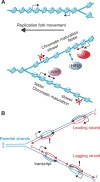Nucleosomes Find Their Place in Life
- PMID: 27650123
- PMCID: PMC5348078
- DOI: 10.1016/j.tig.2016.09.001
Nucleosomes Find Their Place in Life
Abstract
To carry epigenetic information, the chromatin structure must be accurately rebuilt after its deconstruction during genomic replication. Using an elegant, novel approach, Vasseur et al.[1] reveal that transcription plays a key role in sculpting the chromatin after DNA replication.
Copyright © 2016 Elsevier Ltd. All rights reserved.
Figures

Comment on
-
Dynamics of Nucleosome Positioning Maturation following Genomic Replication.Cell Rep. 2016 Sep 6;16(10):2651-2665. doi: 10.1016/j.celrep.2016.07.083. Epub 2016 Aug 25. Cell Rep. 2016. PMID: 27568571 Free PMC article.
References
-
- Sogo JM, et al. Structure of replicating simian virus 40 minichromosomes. The replication fork, core histone segregation and terminal structures. J Mol Biol. 1986;189(1):189–204. - PubMed
Publication types
MeSH terms
Substances
Grants and funding
LinkOut - more resources
Full Text Sources
Other Literature Sources

